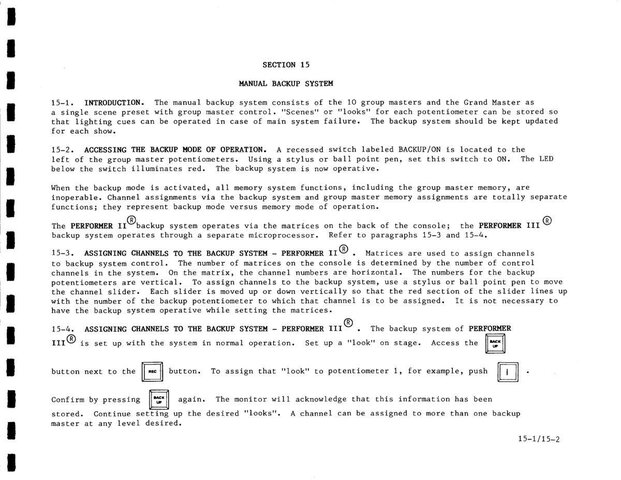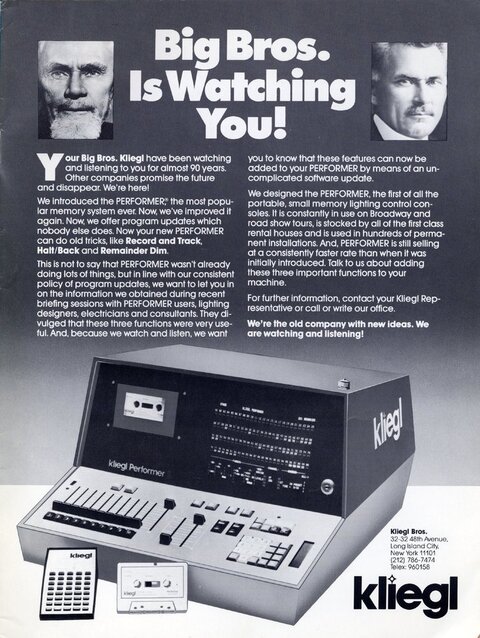You are using an out of date browser. It may not display this or other websites correctly.
You should upgrade or use an alternative browser.
You should upgrade or use an alternative browser.
Control/Dimming 1984 won't be like 1984. (Kliegl Performer)
- Thread starterderekleffew
- Start date
STEVETERRY
Well-Known Member
That ad is like a replay of my often spirited dialogue with Gordon Pearlman:
--Give us tracking (Record and Track)
--Give us remainder dim
--Give us Halt/Back
Ever hear of those features? Light Pallette? Yup!
Those were the days when we were trying to compete with Light Palette because we couldn't buy it. If you were in New York and in the rental business, Four Star was the only company that had access to Light Palette. Frank DeVerna engineered that situation, but once Mini LightPalette came out, Sonny Sonnenfeld made sure we could buy it. Thank you, Sonny--it was a big success at Production Arts.
As for the TI remote, it was never used outside permanent installations.
BTW, that "software update" in the ad was plugging in new 28-pin EPROMs! No Internet, no flash memory, remember? And not even email to check up on how the update was going!
ST
--Give us tracking (Record and Track)
--Give us remainder dim
--Give us Halt/Back
Ever hear of those features? Light Pallette? Yup!
Those were the days when we were trying to compete with Light Palette because we couldn't buy it. If you were in New York and in the rental business, Four Star was the only company that had access to Light Palette. Frank DeVerna engineered that situation, but once Mini LightPalette came out, Sonny Sonnenfeld made sure we could buy it. Thank you, Sonny--it was a big success at Production Arts.
As for the TI remote, it was never used outside permanent installations.
BTW, that "software update" in the ad was plugging in new 28-pin EPROMs! No Internet, no flash memory, remember? And not even email to check up on how the update was going!
ST
Last edited:
What is the purpose of the matrix in the lower left corner?

http://www.pbase.com/paulpelletier/image/64492007
Notes:
The red version shown above is a Performer (I). 96 analog outputs.
Performer II was a 125 channel analog-only output.
Performer III was K96 output.
Performer IV had an entirely new case design, resembling an Apple II, with a separate monitor.

http://www.pbase.com/paulpelletier/lightingconsol&page=2

http://www.pbase.com/paulpelletier/image/64492007
Notes:
The red version shown above is a Performer (I). 96 analog outputs.
Performer II was a 125 channel analog-only output.
Performer III was K96 output.
Performer IV had an entirely new case design, resembling an Apple II, with a separate monitor.

http://www.pbase.com/paulpelletier/lightingconsol&page=2
Last edited:
You (or anyone) can answer now if you wish. I think it's too esoteric a question to be a QotD.
The only thing I can figure is for assigning dimmers to the ten submasters. This would indicate that the console didn't have softpatch. It would also mean a [-]channel[/-] dimmer couldn't be assigned to more than one submaster (overlapping submasters), which the II/III did not have either.
Wow! $24,000 for that POS! How many Elements would that buy? /rhetorical
The only thing I can figure is for assigning dimmers to the ten submasters. This would indicate that the console didn't have softpatch. It would also mean a [-]channel[/-] dimmer couldn't be assigned to more than one submaster (overlapping submasters), which the II/III did not have either.
Wow! $24,000 for that POS! How many Elements would that buy? /rhetorical
Last edited by a moderator:
On the back end of the Performer, the matrices are used for in another style of prehistoric patching (says the 19-year old who's only a few times been blessed with the "opportunity" to use a dying Electro Controls slide-patch system). There are 32 handles, 8 in each matrix, which would correspond to dimmers. Then there are 10 positions for each handle, corresponding to the faders on the front panel.
Not too sure about the entirety of this document, but this may help:
http://www.uky.edu/~jholl2/technology_pdfs/LightingControlHistory.pdf
Source:LIGHTING CONTROL HISTORY AND MODERN PROGRAMMING STRATAGIES Page 6An interesting feature of this board was the inclusion of a backup feature at the left-hand side of the keyboard. The on off switch can be seen at the far left. DIP switches were used to assign one or more channels to each of the sliders. This same type of switch is still used today to address some types of digital equipment. By carefully assigning channels into useful groups, and then manipulating them manually, the operator could run a show even if the computer crashed.
http://www.uky.edu/~jholl2/technology_pdfs/LightingControlHistory.pdf
JChenault
Well-Known Member
Thanks Kirk and John. I ran a Performer II for four years, but never paid attention to that "feature." I don't think we could have run the show on ten handles. Well, we could have, but it wouldn't have been pretty.
From the Performer II/II Manual at Kliegl Bros. Universal Electric Stage Lighting Company

From the Performer II/II Manual at Kliegl Bros. Universal Electric Stage Lighting Company

Last edited:
STEVETERRY
Well-Known Member
Notes:
The red version shown above is a Performer (I). 96 analog outputs.
Performer II was a 125 channel analog-only output.
Performer III was K96 output.
Performer IV had an entirely new case design, resembling an Apple II, with a separate monitor.
The Lighting Console Gallery Photo Gallery by Paul Pelletier at pbase.com
The Performer I was truly an awful console. Gordon Pearlman and Steve Carlson did the design, but the PC layout was done by Kliegl's subcontractor Precision Controls. That resulted in a stacked pair of PCB's with multiple connectors between them. It would not stay working for very long due to interconnect problems.
The Performer II/III came about a year later, and the new PCB layout was done by Gordon and Steve in Portland. Much better! A series of modfications at Production Arts kept the units in rental for quite a long time:
--An output card for Micro II protocol to talk to LMI touring racks
--An output card for DMX512 in 1986
--A new static memory board backed up by a supercap instead of the original dynamic memory backed up by Nicad D cells.
--Externally accessible video adjustment pots for the monitor
ST
Zebulon1880
Member
Last edited:
Similar threads
- Replies
- 16
- Views
- 2K
- Replies
- 2
- Views
- 1K
- Replies
- 0
- Views
- 585
- Replies
- 0
- Views
- 590
- Replies
- 2
- Views
- 769
Users who are viewing this thread
Total: 1 (members: 0, guests: 1)



